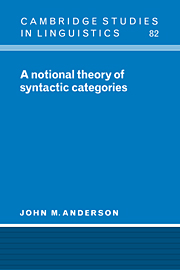
-
Select format
-
- Publisher:
- Cambridge University Press
- Publication date:
- August 2009
- April 1997
- ISBN:
- 9780511519734
- 9780521580236
- 9780521034210
- Dimensions:
- (228 x 152 mm)
- Weight & Pages:
- 0.71kg, 368 Pages
- Dimensions:
- (228 x 152 mm)
- Weight & Pages:
- 0.545kg, 368 Pages
You may already have access via personal or institutional login
Book description
This book presents an innovative theory of syntactic categories and the lexical classes they define. It revives the traditional idea that these are to be distinguished notionally (semantically). It allows for there to be peripheral members of a lexical class which may not obviously conform to the general definition. The author proposes a notation based on semantic features which accounts for the syntactic behaviour of classes. The book also presents a case for considering this classification - again in rather traditional vein - to be basic to determining the syntactic structure of sentences. Syntactic structure is thus erected in a very restricted fashion, without recourse to movement or empty elements.
Contents
Metrics
Altmetric attention score
Full text views
Full text views help Loading metrics...
Loading metrics...
* Views captured on Cambridge Core between #date#. This data will be updated every 24 hours.
Usage data cannot currently be displayed.
Accessibility standard: Unknown
Why this information is here
This section outlines the accessibility features of this content - including support for screen readers, full keyboard navigation and high-contrast display options. This may not be relevant for you.
Accessibility Information
Accessibility compliance for the PDF of this book is currently unknown and may be updated in the future.


